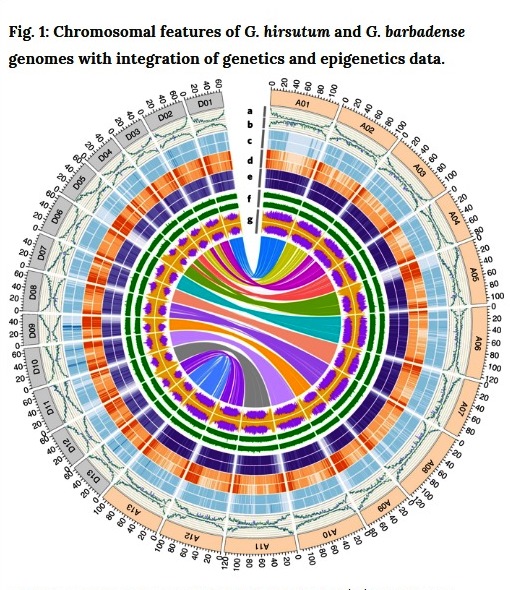Reference genomes of two allotetraploid cultivars, contributed by Huazhong Agricultural University, China, Published in Natural Genetics on 03 December 2018. Data available at CottonGen JBrowse and CottonGen BLAST
Title: Reference genome sequences of two cultivated allotetraploid cottons, Gossypium hirsutum and Gossypium barbadense
Authors: Maojun Wang, Lili Tu, Daojun Yuan, De Zhu, Chao Shen, Jianying Li, Fuyan Liu, Liuling Pei, Pengcheng Wang, Guannan Zhao, Zhengxiu Ye, Hui Huang, Feilin Yan, Yizan Ma, Lin Zhang, Min Liu, Jiaqi You, Yicheng Yang, Zhenping Liu, Fan Huang, Baoqi Li, Ping Qiu, Qinghua Zhang, Longfu Zhu, Shuangxia Jin, Xiyan Yang, Ling Min, Guoliang Li, Ling-Ling Chen, Hongkun Zheng, Keith Lindsey, Zhongxu Lin, Joshua A. Udall and Xianlong Zhang
Abstract: Allotetraploid cotton species (Gossypium hirsutum and Gossypium barbadense) have long been cultivated worldwide for natural renewable textile fibers. The draft genome sequences of both species are available but they are highly fragmented and incomplete1,2,3,4. Here we report reference-grade genome assemblies and annotations for G. hirsutum accession Texas Marker-1 (TM-1) and G. barbadense accession 3–79 by integrating single-molecule real-time sequencing, BioNano optical mapping and high-throughput chromosome conformation capture techniques. Compared with previous assembled draft genomes1,3, these genome sequences show considerable improvements in contiguity and completeness for regions with high content of repeats such as centromeres. Comparative genomics analyses identify extensive structural variations that probably occurred after polyploidization, highlighted by large paracentric/pericentric inversions in 14 chromosomes. We constructed an introgression line population to introduce favorable chromosome segments from G. barbadense to G. hirsutum, allowing us to identify 13 quantitative trait loci associated with superior fiber quality. These resources will accelerate evolutionary and functional genomic studies in cotton and inform future breeding programs for fiber improvement.

